D.6 Case studies of HER enhancement projects
- D.6 Case studies of HER enhancement projects
- D.6.1 Creating an event record and GIS layer
- D.6.2 Providing historic mapping for the HER : the Worcestershire Tithe Map Project
- D.6.3 Creating a deposit model for the Palaeolithic in Worcestershire
- Using the BGS data
- Adding the HER data
- The result
- D.6.4 Prehistoric funerary and ritual sites
- Introduction
- Methodology
- Results
- D.6.5 The Shorewatch (SCAPE) Project
- D.6.6 HER21: Historic Environment Records for the 21st century
- D.6.7 Using museum collections and online archives for HER enhancement: Enhancement of early prehistoric information within the Norfolk Historic Environment Record
D.6 Case studies of HER enhancement projects#
D.6.1 Creating an event record and GIS layer#
Stuart Jeffrey, West of Scotland Archaeology Service (WoSAS)The recommended Event Monument Source (EMS) model for SMR management has meant that those SMR databases that have been historically developed with these three elements undifferentiated have required extensive restructuring. At WoSAS this process was seen as an opportunity to develop a more sophisticated GIS polygon layer representing archaeological events that could inform development control directly as well as offering a further resource to be supplied as baseline data to contracting units. The project to remove and restructure existing event records from the SMR and to enter unrecorded events from the existing paper archive as well as defining them in the GIS was carried out over a period two years. However, this does not represent full time work by a single individual, as the work was conducted as intermittent work by a number of WoSAS staff and volunteers.
The resulting Events recording system has a database record and GIS point for every known event in the record from the nineteenth century to the present and range from forestry surveys to geophysical surveys to area excavation. Each Event is directly related to the relevant Sources and Monuments. “Live Events”, that is those that have been started but not yet completed are also represented in the Events database as well as WoSAS's development control management (Consultation) system. The definition of archaeological events in a polygon layer in the GIS was complicated by various ambiguities and variations in precision in the available spatial descriptions, which ranged from poor textual references to highly accurate digital data derived from GPS survey. A series of metadata fields were incorporated into the Event polygon layer in order to inform users of the accuracy of the source data. This allows Events defined accurately to, for example trench level, to share a layer with Events such as poorly defined unsystematic reconnaissance surveys. These fields are Feature, Source, Confidence and Results, their contents are constrained by a list of specific values. An example of polygon attributes in the GIS might be:
| Event ID | 1076 |
| Compiler | MO'H The initials of the staff member who created the polygon. |
| Map_scale 2500 | The scale of the base map used in digitising if appropriate. |
| Dig_scale 1500 | The scale at which the map was displayed for digitising. |
| Entry date | 13/05/2004 The date the polygon was created. |
| Name | Archaeological Field Evaluation and Watching Brief at Tollpark, Cumbernauld, North Lanarkshire* |
| Director | Duffy, P* |
| Organisation | GUARD* |
| Year | 1998* |
| Context_comment | Work carried out during construction of a car park to the north of a factory (and trenching at camp), to check if there are any archaeological remains. Condition attached to the planning consent. |
| Results_comment | No archaeological remains were found. |
| Sub_Event | Trench 1 The designation of this polygon where the event is represented by more than one polygon |
| Source Code | (1) Digital data from contractor (EDM survey) |
| Feature Code | (5) Trench extent – Trial Trench |
| Confidence Code | (6) Accurate to within 1m |
| Results Code | (8) Entirely negative |
All elements are derived from the GIS Layer attribute table except those marked with an asterisk, which are derived from the SMR database Event Record via an ODBC link. Although the vast majority of polygons represent site/survey extents, where good data is available down to trench level, as in the above example, it can be incorporated into the GIS layer. This most often happens when survey data is supplied digitally by the contracting unit or when it can be digitised satisfactorily from a paper report.
 |
Currently the WoSAS Event record comprises c.1500 archaeological events, represented in the GIS by c.1500 points (one centred on each event) and c.1000 polygons. The next phase in enhancing the Events record is to develop XML download scripts working directly with OASIS as it is implemented in Scotland. This should allow the population of the SMR record directly from the contractor's on-line record (after validation) as well as the up-loading of contractor supplied geo-referenced survey data. Work is also under way in partnership with the RCAHMS to specify geospatial data standards in Scotland, including an examination of the applicability of existing standards. It is also hoped to generate and incorporate new event polygons derived from information contained in past journals under the auspices of a museum led project to develop a Local History and Archaeology Strategy for the Clyde Valley.
This enhancement to the system has proved enormously valuable, both as an improvement to WoSAS's own suite of business tools and as a more usable source of events information for contractors working in the WoSAS area. This is often crucial in making archaeological decisions on the ground and overcomes the occasional lack of communication between commercial archaeological contractors regarding their most recent work (commercial sensitivities are always respected). An additional benefit of having carried out this process is that it has encouraged archaeological contractors to deposit digital geospatial data directly with WoSAS in the knowledge that it will be rapidly incorporated into the SMR datasets.
 |
D.6.2 Providing historic mapping for the HER : the Worcestershire Tithe Map Project#
Neil Lockett, Worcestershire Historic Environment RecordDuring the eighteenth and nineteenth centuries much of the English landscape was undergoing significant change. The surveys of the Tithe Commissioners have helped to document this process through the detailed maps of land-holdings and their associated lists which provide details of each land parcel: its owners, tenants, and how it was used. These maps offer a fascinating insight into the agricultural landscape of the day, and clues, through place-names, to earlier settlement patterns.
The Worcestershire Tithe Map Project has been investigating original tithe maps, held by the County Record Office, for the past twelve years. This investigation, undertaken by volunteers, has produced tracings of the original maps to a uniform scale of 1:10,000 so that they can be overlain onto modern Ordnance Survey paper maps. Place-name evidence, derived from the accompanying documentation has also been added.
This early stage of the project emphasised the value of tithe maps in any study of historic landscape and demonstrated a demand for easy access to this information from individuals, local groups and heritage professionals. In response to this, in 2002 it was decided to digitise the data held within the maps and associated apportionment books.
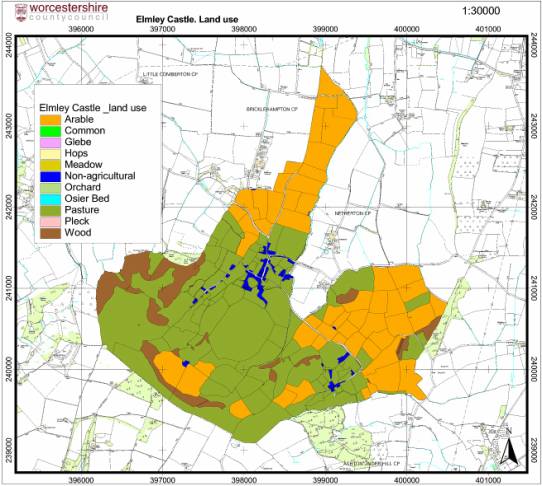 |
Since 2002, the project has used a Geographic Information System (GIS) to trace the maps as digital cartographic documents, which can be used in a more sophisticated manner than the paper tracings. Each parish tithe map is traced as a single, multi-layered document, so that field-parcels, buildings, roads, and other features can be easily isolated and displayed at will (Figure 30). The resultant digital coverage can be used alongside other tithe maps, estate maps, or modern and historic Ordnance Survey maps. Other digital information, such as Public Rights of Way or Historic Environment information can be displayed and analysed in conjunction with the tithe maps.
As well as tracing the maps, details of the contemporary Schedule of Apportionment listing: ownership, tenancy, rentable value, land-use and placename has been compiled onto a database. The combination of the digital maps and this database enables the data to be displayed in a variety of ways allowing researchers to readily visualise early nineteenth century land-use, ownership and tenancy patterns. In addition, individual parish maps can be combined to view larger historic settlement patterns and, when the project is completed it will be possible to search for, amongst other data fields, placenames or personal names across the whole county.
The project has been funded by Worcestershire County Council, and by Local Archaeological and Historical Societies who received grants from the Local Heritage Initiative scheme. The current coverage for transcribed tithe maps stands at 138 parishes, held as 1:10,000 copies suitable for overlay onto paper Ordnance Survey maps. Of these transcriptions, 42 have been converted to digital coverages. In addition fourteen late eighteenth century Enclosure maps are available, together with five maps documenting two estates in Worcestershire. The project intends to complete all available tithe maps for Worcestershire as digital coverages, and hopes to extend the enclosure and estate map coverages in the near future. All of the completed maps can be consulted at the HER and will be published to the web site (http://www.worcestershiremaps.org.uk/ ) in order to promote research, at all levels, into Worcestershire's past and aid understanding of how the landscape has changed over the past 160 to 170 years.
) in order to promote research, at all levels, into Worcestershire's past and aid understanding of how the landscape has changed over the past 160 to 170 years.
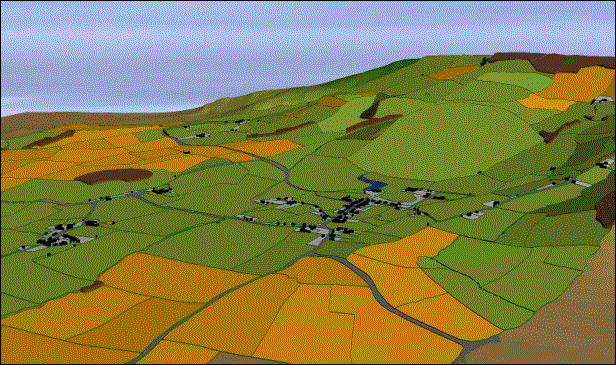 |
D.6.3 Creating a deposit model for the Palaeolithic in Worcestershire#
Neil Lockett, Worcestershire Historic Environment Record and The Shotton Project, University of BirminghamNationally the Lower and Middle Palaeolithic periods have had a high profile over the last decade. In the Midlands, however, there has been a general lack of research and a shortage of finds.
The Shotton Project, www.arch-ant.bham.ac.uk/shottonproject developed by the University of Birmingham and funded by the Aggregates Levy Sustainability Fund, was an attempt to address this lack of research. From the outset it was clear that the results of the Project, both new data and assessments of archive material, would be of more use to archaeological curators and researchers if they were integrated into the relevant HERs. At the time, no such integrated record existed for Quaternary and Palaeolithic material in Britain.
developed by the University of Birmingham and funded by the Aggregates Levy Sustainability Fund, was an attempt to address this lack of research. From the outset it was clear that the results of the Project, both new data and assessments of archive material, would be of more use to archaeological curators and researchers if they were integrated into the relevant HERs. At the time, no such integrated record existed for Quaternary and Palaeolithic material in Britain.
Worcestershire HER saw the benefit of this process and its staff were involved in a pilot project to test the integration of Shotton Project data into an HER. This pilot project involved creating a deposit model for the Lower Palaeolithic
Two main datasets were used:
- Digital geological mapping from the British Geological Survey (BGS) mapped at a base scale of 1:50,000 (DigMap50). This was used to provide a base from which Palaeolithic deposits could be derived.
- Search results from the HER for all sites or find spots of a Palaeolithic date (500,000 to 10,001 BC).
Using the BGS data#
The ten 'tiles' of vector data, corresponding to the original BGS 1:50,000 paper map sheets were merged into a single vector layer. This data was then reprocessed to focus on the features relevant to the Palaeolithic. The completed theme contained all terraces of the Severn and Midland Avon as individual features.At the same time a literature study provided background information to the current geological interpretation of the Midlands. This study covered two main sources:
- the BGS Sheet Memoirs – books written to accompany the drift geological sheets providing interpretative discussions on the geology.
- geological correlations for the Quaternary recently published by the Geological Society. This provided information on the correlations, formations and terrace sequences for the County. From these sources it was possible to add additional attributes to Palaeolithic deposits to enabled querying and display of the theme based on the following fields:
- Lexicon Name
- Formation Name
- Member Name
- Terrace
- Date Range (Figure 32)
- Minimum Date
- Maximum Date
- Marine Oxygen Isotope Stage
- Period
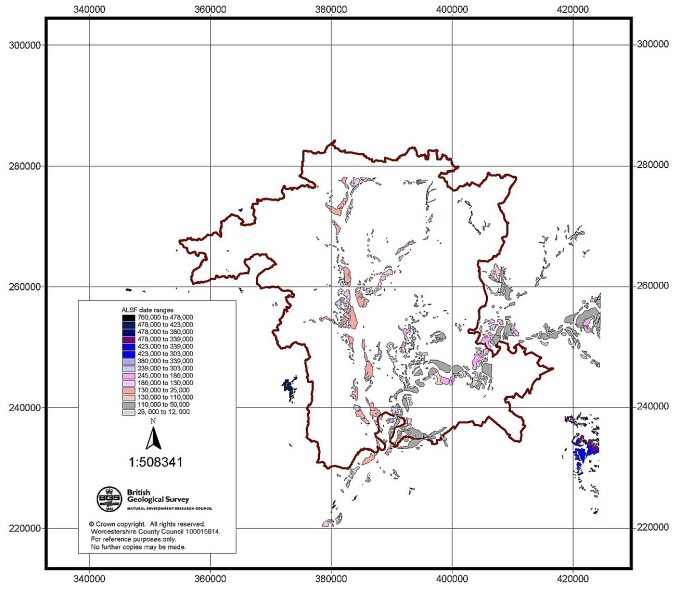 |
To clarify the importance of the Quaternary aspects of the record, type sites were included (Figure 33). These type sites provide important information on date ranges and evidence of vertebrates and invertebrates through organic deposits. Only one of the type sites used here had archaeological material within associated contexts. This demonstrates the importance of using non-heritage data sets to make a more complete Palaeolithic and Quaternary HER.
Adding the HER data#
Once the background geology had been established, it was possible to add in the information held in the HER. Information from the enhanced drift geology coverage was linked to the HER data using a spatial join. This provided refined date ranges for many sites contained within the HER and also gave the specific terrace deposit and formation information which could be used to enhance the core HER data (Figure 34).The result#
The creation of county-wide coverage, containing period and date-range information forms the basis of a Palaeolithic interpretative model which can be incorporated into future research and management programmes. The layer will form the basis of a testable model for the survival of deposits of this period within the county.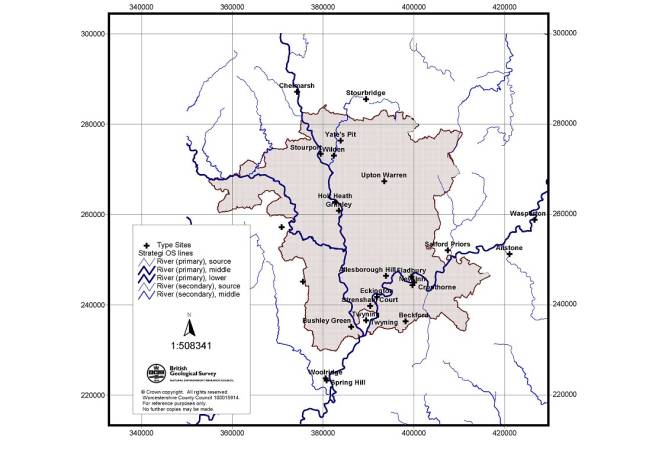 |
The GIS work involved in the creation of the predictive model took four days work. This partnership project has proved, therefore, a cost-effective way of producing such models for inclusion within the HER. The project has highlighted that the successful completion of this type of enhancement project requires a detailed understanding of data sources, both strength and weaknesses, but most importantly a multidisciplinary team.
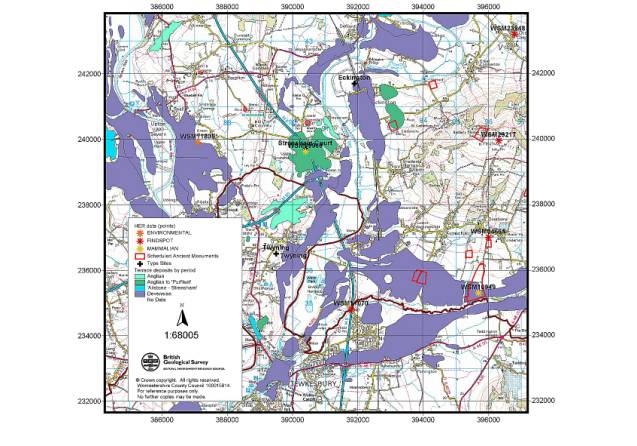 |
D.6.4 Prehistoric funerary and ritual sites#
Jeff Spencer, Clwyd-Powys Archaeological TrustIntroduction#
In 1997 the Clwyd-Powys Archaeological Trust (CPAT) started a Prehistoric Funerary and Ritual Sites project, a comprehensive study of Neolithic and Bronze Age sepulchro-ritual monuments in east and north east Wales. The initial stage of the survey in the Upper Severn Valley, Powys, served as a pilot for what has evolved into a pan-Wales project involving all four Welsh Archaeological Trusts.The work has been funded by grant aid from Cadw, as part of a national assessment and survey project, and is one of a number of similar themed or period specific projects run by Cadw over the past 10 years. Such projects are designed to audit, assess and report on the condition of a particular aspect of the archaeological resource and to identify management issues and suggest solutions to resolve these. As well as specifically producing management prescriptions and recommending sites for scheduling, one of the key ways in which improved management is delivered is through the systematic enhancement of the HER - thereby improving its various heritage management functions including development control, advice to agri-environment schemes and forestry proposals.
Since 1997 CPAT have studied 7 geographical areas in a series of annual projects, details of which can be found at http://www.cpat.org.uk\projects\longer\pfr\pfr.htm . By its expected end in March 2006 the project will have run across Wales. Completion would have been achieved sooner but for the serious disruption caused by the outbreak of foot and mouth disease in 2000/01.
. By its expected end in March 2006 the project will have run across Wales. Completion would have been achieved sooner but for the serious disruption caused by the outbreak of foot and mouth disease in 2000/01.
Methodology#
The HER was interrogated to extract a digital project database of all sites which potentially fell into the category of Neolithic or Bronze Age funerary and ritual sites. It included sites where the most likely interpretation was not necessarily either prehistoric, or funerary or ritual, but where other, less likely interpretations fell within the scope of the study. For example, cairns which were likely to be clearance cairns, but which may alternatively be burial cairns.The initial extract of sites was reassessed, taking into account the HER description and any readily available written sources. As a result some sites were excluded from the study on the grounds that they were not considered to be prehistoric in date, belonged to a category of monument other than funerary or ritual, or because they were duplicate records. Records generated from placenames and fieldnames (such as maen, carreg, carnedd, domen and gorsedd which in Welsh may denote the site of a burial mound, standing stone or stone circle, for example) were checked and, where site visits over the years had failed to produce evidence of an archaeological site, were also excluded.
Rapid visits were made to as many sites on the project database as possible, records completed, and their form and condition of the monument assessed, and the project database enhanced. A photographic record was also made and linked to the database.
 |
Results#
- Existing HER entries for all sites in the initial project database were enhanced by improving the detail and accuracy of records, or by adding new information.
- Previously unknown sites were discovered, recorded and subsequently added to the HER.
- Significant groupings of previously recorded sites were recognised, for example round barrow cemeteries and prehistoric monument complexes.
- A consolidated list of site types and site type definitions for prehistoric funerary and ritual monuments was developed, and the list of revised site types applied to the database entries.
- A wide range and large number of sites were recommended for scheduling. Cadw has subsequently granted this status to many of them.
- Specific management data was prepared to support the heritage management functions of the HER.
- A range of publications detailing the work for a variety of audiences have been prepared, including a volume in Cadw’s Caring for . . . series of heritage management advice booklets.
D.6.5 The Shorewatch (SCAPE) Project#
Tom Dawson, University of St AndrewsWith one of the longest coastlines in Europe, Scotland has a great number of archaeological sites in distant and exposed locations. The remoteness of much of the coast means that there are large tracts that have not yet been systematically surveyed by archaeologists. Additionally, in many areas the coast is changing rapidly due to sea and wind erosion, leading to previously unrecorded archaeological sites being revealed on a regular basis.
In order to gather information on this vulnerable heritage resource, Historic Scotland has commissioned coastal surveys at a number of locations, and approximately twenty five percent of the coast has now been explored. Professional units have undertaken the work and all new surveys since 2000 have been managed by SCAPE (Scottish Coastal Archaeology and the Problem of Erosion), a charitable organisation concerned with promoting work on Scotland’s coastal heritage.
SCAPE is also co-ordinating shorewatch, a project aimed at encouraging members of local communities to locate, record and monitor sites on the coast. Groups have been established around Scotland, including on many of the far-flung islands. The groups have received training in how to identify and describe sites and are provided with a resource pack that explains how to work on the project. Many groups have also been provided with basic equipment, including hand-held GPS receivers to help with recording site locations.
Shorewatch participants use pro forma sheets to record details about sites, designed in consultation with staff from the National Monuments Record of Scotland and local SMRs, and conforming to guidelines laid out in the MIDAS manual (Lee 1998). The forms are used to record details about new sites and provide a basis for future monitoring. The completed forms are sent to the Shorewatch co-ordinator for initial checking, which includes entering the details into a database linked to GIS to verify grid references. The forms prompt the group members to record all essential details, and as part of their initial training, group members are asked to record a monument on a blank piece of paper. They are subsequently given a form to record the same monument and then compare the results, allowing them to see how much more information is usually noted down when following the prompts.
The Shorewatch project has been adopted by pre-existing local heritage, history and archaeology societies, and new groups have also been set up specifically to work on the project. Additionally, the SCAPE managed coastal surveys have included a necessity for the professional units involved to provide training to Shorewatch groups. In areas where no groups previously existed, the units, together with the Shorewatch co-ordinator, have either contacted existing heritage organisations or have written articles in local papers and held meetings in halls in order to set up new groups from scratch.
As well as recording sites located in remote places, the use of local groups has proved extremely useful for reporting remains found eroding after a storm or similar event. Some Shorewatch groups are also well-placed to investigate the intertidal zone, being able to visit during low spring tides. Health and Safety is an obvious concern and risk assessment forms and a section of the resource pack help to make participants aware of potential dangers.
In many cases, Shorewatch group members had been monitoring sites over a number of years prior to participation in the project, but had been unaware of how to report their findings. Involvement in the project has helped the groups to understand the workings of local and national records and has provided a mechanism for reporting their findings.
The number of records returned by groups range from occasional notes about a handful of sites to the results of intensive surveys. An example of the latter is the two seasons of work completed by volunteers from the North of Scotland Archaeology Society (NoSAS). They have been surveying the very remote Loch Hourn, walking its shore and immediate hinterland. They have located over four hundred sites that were previously unrecorded in local or national records, and have changed our understanding of human interaction at the loch. Many of the sites relate to the herring fishing industry and include quays, terraces and the footings of buildings. After completion of each season of survey work, group members have compiled a comprehensive report, with summaries for Discovery and Excavation in Scotland. They have also added details of the sites to the Highland Council SMR, after verification of the records by an SMR officer.
 |
Many groups have developed a sense of responsibility for sites in their locality, and have adopted some of these for further study. Such work can include making detailed plans and arranging regular monitoring visits. A few groups have started more intensive work at sites that are threatened with imminent destruction. In collaboration with SCAPE and the local authority Archaeologists, they have begun recording projects aimed at rescuing information that would otherwise be lost. At Brora, Sutherland, the Clyne Heritage Society has been investigating the substantial masonry remains of sixteenth century saltpans eroding on the beach and from dunes. Members of the Society have monitored the great damage that storm tides have done to the walls and are uncovering masonry hidden below drifted sand, drawing plans and making a photographic record of the buildings.
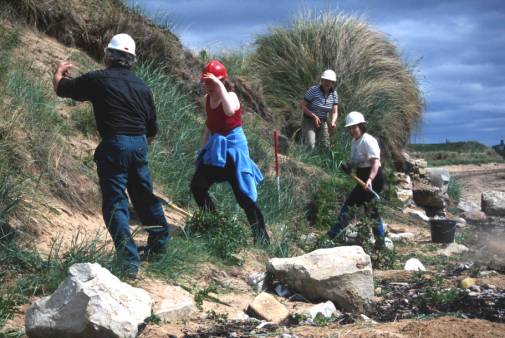 |
The Unst Heritage Society, based in Shetland on Britain’s most northerly inhabited island, has been working with professional archaeologists to record an eroding prehistoric dwelling. They had been monitoring the destruction of the structure over a number of years and have recently completed a geophysical and topographic survey of the site, together with limited excavation of the eroding face. The professional archaeologists have provided formal training for the group and have helped them with the recording. Society members have arranged a display in the local heritage centre about their recent work, using this as a means of informing the entire island community of their activities and further stimulating local interest in heritage recording.
 |
D.6.6 HER21: Historic Environment Records for the 21st century#
As part of its on-going strategy to support the development of HERs, English Heritage, now Historic England, commissioned a programme of projects known as HER21 or ‘Historic Environment Records for the 21st century’. In addition to strategic research, 12 projects undertook to expand the content and coverage of HERs and provided methodologies accessible to other HERs. The results of the programme inform Historic England’s forward looking national strategy for HERs. The individual case studies can be found at https://www.historicengland.org.uk/advice/technical-advice/information-management/support-for-hers/
D.6.7 Using museum collections and online archives for HER enhancement: Enhancement of early prehistoric information within the Norfolk Historic Environment Record#
Alice Cattermole, Norfolk Historic Environment RecordAs part of a recent English Heritage-funded project (6623: Enhancement of early prehistoric information within the Norfolk Historic Environment Record), Norfolk County Council’s Historic Environment Service undertook systematic enhancement of all monument, source, find and event records relating to the early prehistory of the county. This case study highlights the huge potential of working with museum collections and online archives to update and enhance HER records, and to facilitate the signposting of museum collections from HERs.
Norfolk’s early prehistory has long been the focus of study and interest, with nineteenth- and twentieth-century antiquarians regularly combing its beaches and gravel pits in search of traces of our earliest human ancestors. More recently, the spectacular discoveries made by the Ancient Human Occupation of Britain project at Happisburgh and excavations at Lynford Quarry have demonstrated the potentially internationally significant character of the county’s early prehistoric remains. However, prior to our recent enhancement project, early prehistoric material was not well-represented with the Norfolk HER (NHER), with many of the early discoveries being either entirely absent or only represented by incomplete bibliographic references. Much of the material was broadly classified as ‘early prehistoric’, and a large number of artefacts had only been assigned the find type ‘lithic implement’. In order to enhance these records, we attempted to draw together all relevant sources of information and systematically incorporate them into the NHER.
While we had access to many detailed finds descriptions and illustrations in the NHER paper files, which we were able to use to enhance the NHER database records, we were also conscious of the fact that many researchers often wish to make a physical examination of early prehistoric material within museum collections, so wherever possible we wanted to be able to signpost this material from the NHER. For this reason, we included the assessment of all early prehistoric material in the Norfolk Museums Service’s collections and the selection of key artefacts and groups of artefacts for digital photography and/or illustration as part of this enhancement project. This task was limited to NMS collections because we were confident that a significant proportion of the early prehistoric material discovered in the county had been donated to NMS, and because it was not practically possible to include examination of material in other collections within the scope of this project.
Our objective was to ensure that the NHER included details of all objects of probable Palaeolithic or Mesolithic date held by Norwich Castle Museum (NCM) and the smaller museums at King’s Lynn, Thetford, Great Yarmouth and Cromer. In order to do this it was necessary to gain access to NMS’s MODES collections database. Various searches were undertaken in order to identify and highlight the records likely to relate to Palaeolithic and Mesolithic objects. In total 1,068 collections and individually accessioned objects were identified, the majority of which are held by NCM, although Thetford and King’s Lynn museums also hold significant early prehistoric collections.
The quality of NMS’s collections database records varied considerably; in many cases they were quite detailed, and occasionally they contained important information that was not recorded by any of the other available sources. Much of this information was relatively straightforward to integrate, particularly in the instances where NHER numbers had been listed. Where NHER references were not listed it was necessary to rely on recorded grid references, site names and parishes in order to establish the location of particular discoveries. Any NMS MODES records which had missing or incorrect NHER numbers were amended at the end of the project, further improving the links between MODES and the NHER. This is something which it is hoped will be developed further and included in any future HER enhancement projects.
As well as integrating descriptive information relating to early prehistoric material in NMS’s collections, we were able to borrow much of this material and ensure that a representative sample of these artefacts were illustrated and/or photographed. The physical examination of these collections also resulted in a number of additional corrections and additions to the related finds records. Digital photographs were taken of over 400 separate objects from NMS collections, providing a broad cross-section of the early prehistoric material in these museums. These photographs have been edited to create composite images following Portable Antiquities Scheme guidelines and linked to the relevant HER records. They have also been supplied to NMS in order for these to be integrated into their digital catalogue.
For artefacts in private collections and in museums other than the NMS, it was agreed that references to this material would be added to the HER where possible but that no further assessment of this material would take place. References were added from secondary sources, with additional information sometimes being obtained from online collections databases and catalogues. One of the greatest difficulties encountered during this process was keeping track of the transfer of objects from one museum or collection to another, and some of the confusion around the quantification of certain objects was resolved once it was established where objects had been transferred between collections and had in effect been double-counted. The time we invested in disentangling such confusion has paid dividends in terms of enabling us to be much more confident about our recording of the locations of key early prehistoric collections and artefacts, as well as quantifying the material more accurately.
As well as using museum collections to enhance our records, another invaluable resource which we were able to fully utilise for the first time as part of this project was some of the archives that have recently been made available online. We had not previously been able to devote any HER staff time to detailed examination of any online archive material. The archive of the late John Wymer (1928–2006), one of the country’s leading Palaeolithic specialists, was identified as an important resource for those researching the county’s early prehistory, especially since Wymer spent almost a decade working in Norfolk. A key element of the archive is Wymer’s eight field notebooks, which were digitised by Wessex Archaeology as part of a project commissioned by English Heritage (with the support of the Aggregates Levy Sustainability Fund). These notebooks record the majority of the site visits which Wymer made between 1949 and 2003 and contain extensive notes as well as site location plans, section drawings and photographs. They also record all of the individually numbered objects that were once part of his personal collection, including finds he recovered himself as well as material which he had inherited from his father. A proportion of these objects were recovered in Norfolk, many of which had not been recorded in the NHER prior to the start of this project.
Another key component of the Wymer archive is the card index he compiled detailing virtually all known Lower and Middle Palaeolithic finds in the country. These records were generated over the course of many years and would form the basis for two major research projects which were undertaken by Wymer in conjunction with Wessex Archaeology: the Southern Rivers Palaeolithic Project and the subsequent, larger, English Rivers Palaeolithic Project (TERPS). Although a number of publications were produced at the conclusion of these projects these inevitably contained only a proportion of the information which had been recorded. The TERPS dataset was digitised at the same time as Wymer’s notebooks and this was identified as an important source. Although this database does not contain Wymer’s detailed artefact descriptions, it nevertheless contains much important information, including site notes not found elsewhere and full bibliographic references. Linking the TERPS database to the NHER was straightforward as Wymer had recorded NHER numbers for almost all of the 230 Norfolk entries. Provision had only been made for the integration of material from the Wymer archive. However, during the course of the project, it came to our attention that the archive of the late Dr Roger Jacobi had also recently been digitised. This is an invaluable resource for the study of the Upper Palaeolithic and Mesolithic periods in Britain. The principal component of the archive is Jacobi’s extensive card index, which includes information on the thousands of artefacts which he examined over the course of his career. It also incorporates the information gathered during research for the CBA Mesolithic gazetteer (Wymer and Bonsall 1977). This card index formed the basis for the Palaeolithic and Mesolithic Lithic Artefact (PaMeLA) database, compiled by Wessex Archaeology as part of the English Heritage-commissioned Colonisation of Britain by Modern Humans project. The resultant Colonisation of Britain Database (CBD) is important because it provides not only information on particular sites, but also detailed descriptions of many individual objects. Within the Jacobi archive there were 587 entries for Norfolk which resulted in additions to over 225 monument records.
The purpose of this case study is to illustrate the huge potential that museum collections and online archives have for HER enhancement work. By giving us the capacity to systematically work through the existing catalogues and material archives held by the NMS, as well as other digitised archives, this English Heritage-funded project enabled us to enhance greatly our records relating to Norfolk’s early prehistory. This enhancement has already had an immediate benefit for development management and outreach and engagement within the county, as well as feeding into several major pieces of academic research. The work has also highlighted several rich sources of information which are of great relevance to other HERs, in particular the digitised Wymer and Jacobi archives, and we would encourage the HER community to search these archives for material relevant to their own collection areas.